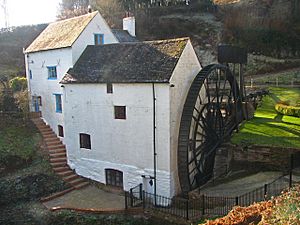Daniels Mill, Shropshire facts for kids
Daniels Mill is a special working water mill located near Bridgnorth in Shropshire, England. It grinds flour, just like mills did many years ago. What makes it really stand out is its huge cast iron waterwheel. This wheel is the biggest of its kind in England, measuring about 38 feet (11.6 meters) across!
The mill operated until 1957, grinding different types of grain, mostly for animal feed. It stopped working when the miller, whose son now owns the mill, passed away. After a lot of hard work to fix it up, Daniels Mill opened its doors again in 2008.
Contents
The Mill's Long History
Daniels Mill is nestled below the Oldbury Viaduct, a large bridge that carries the Severn Valley Railway line.
Early Days of the Mill
The first mentions of this mill and the land around it date back to the late 1400s. Back then, it was known by names like "Donynges" or "Dunnings" Mill. It was part of a large estate owned by the Ottley family, who owned much land in the Bridgnorth area. The mill stayed with this estate until the 1700s. In those early centuries, the mill was likely run by a "journeyman miller." This was a miller who traveled around, visiting the mill only when there was grain to grind.
How the Mill Changed Over Time
Daniels Mill has been made bigger and changed many times. The building you see today looks very different from its original design. It was probably a smaller, lower building with two floors. The first waterwheel was likely made of wood and was much smaller than the huge iron one now. It was also probably in a different spot.
The Crowther family were some of the first millers who lived at the mill. They likely made the mill bigger and added proper living spaces. This first big change probably happened around the early 1600s. At that time, land was bought to create an upper water pool. A smaller mill, known as the "mill in the hole" or Clover Mill, was built under the dam of this new pool. Today, only the back wall and the wheel pit of this smaller mill remain. The newest part of the main mill building, shaped like an "L," was added last. It included a kitchen, a bedroom, and an attic.
The Giant Waterwheel
The impressive cast iron waterwheel you see today was made in 1854 at Coalbrookdale, a famous ironworks. It replaced an older wheel around the mid-1800s. Records show that as early as 1843, a steam engine was bought to help the mill work alongside the waterwheel.
For many years, the mill house didn't have many modern updates. This continued until 1946, when the miller, Henry Thomason, finally had electricity installed in the house. However, Mr. Thomason refused to add electricity to the mill itself, believing it would be too dangerous. When he passed away in 1957, the mill stopped working for a while.
Bringing the Mill Back to Life
In 1958, work began to restore Daniels Mill. A huge amount of effort went into fixing it. This included repairing water damage to the wheel and rebuilding walls around the wheel pit. A new steel axle was put in, and the millstones and their wooden frames were replaced. Floorboards and windows were also fixed. The restorers were careful to use old materials, often found from other demolition sites.
Modern Restoration Efforts
In 2007, Daniels Mill received a grant of £67,500 from the GrantScape Community Heritage Fund. This money helped bring back the second way water could flow to the wheel. This involved rebuilding a large water pool and an underground pipe. They also reconstructed the overwheel water tank, which had been removed in the mid-1960s because it was unsafe.
While this work was being planned, the mill was badly damaged by serious floods in the summer of 2007. More funding was secured from the Shropshire Tourism Action Plan programme and European Rural Development Funds. This helped upgrade the site and make it easier for visitors to access. Other groups, like the Society for the Protection of Ancient Buildings, Bridgnorth District Council, and the Midlands Mills Group, also helped. Money raised from the public also contributed. All this support helped fix the wheel and its workings so that three sets of millstones could turn again. All these projects were completed, and the mill officially reopened in July 2008.
During 2008, work also began to uncover the ruins of the smaller mill. During these digs, pieces of millstones were found, including one large English millstone. They even found evidence of an even older waterwheel!
See Also
- Listed buildings in Eardington


